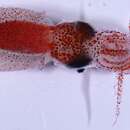en
names in breadcrumbs


“Psychroteuthis glacialis, Thiele, 1921
Sta. 91, November 5, 1965. Trawling depth 410-396 m. 1♀; ML – 128 mm
Sta. 200, March 15, 1965. Trawling depth 560-730 m. 1♀; ML - 131 mm
A single species of this endemic antarctic genus has been described (Thiele, 1921) from the fragments of some specimens taken from the stomachs Weddell seals and penguins in the Antarctic. There have been no records of living specimens until now. Therefore description of our specimens would be useful.
Description. (Fig. 6) The mantle cylindrical, tapering rapidly from the beginning of the fins. The anterior mantle margin is slightly produced dorsally in the midline, while ventrally it is emarginated beneath the funnel with small lateral lappets (Fig. 6a).
The fins are large, rhomboidal, wider than long, with the length slightly exceeding half the mantle length.
The head is narrower than the mantle, with small eyes and 2 neck folds on each side of the head.
The funnel is wide at its base, and tapers rapidly to the safe end. It is short and reaches to about the level of the eyes. The funnel organ consists of an inverted V-shaped dorsal pad with a small papilla in the middle of its anterior margin and 2 ventral oval pads.
The funnel cartilage is simple with a somewhat sinous, longitudinal groove. The corresponding member on the mantle is a ridge of the same length.
The arms are moderately long, stout in the base, gradually tapering to the end. Their suckers are biserial and are protected on either side by a low protective membrane. The suckers are provided with smooth horny rings except the terminal ones which have finely toothed rings (Fig. 6e).
TABLE 2. The measurements (mm) and indices of 2 specimens of P. glacialis
♀
♀
ML
128
131
MWI
-
24.4
FLI
57.7
57.2
FWI
71.8
64.8
arms
I
44.5
56.4
II
53.1
59.5
III
51.5
57.2
IV
50.7
55.7
The tentacles are considerably longer than the arms, with the strong, slightly expanded clubs curved like palms (Fig. 6b). The club bears 4 rows of suckers with horny rings provided with sharp teeth bent outwards (Fig. 6f). The central suckers have 25-26 teeth. Some of the suckers of the central rows are distinctly larger than the outer ones. The distal part of the club bears minute suckers which sit in 5 rows. At the base of the club there is a row of minute adhesive suckers and pads which run along the tentacle stalk.
The gladius is lanceolate, weak and transparent, with a short rachis, rather wide and long vane, the margins of which are fused in the distal part and form a pocket without a bottom (Fig. 6c). The gladius does not reach the end of the body.
There are no photophores. The skin is thin and lightly coloured.
Both specimens are females with ovaries and nidamental glands insignificantly developed.”
(Filippova, 1972: 398-400)
Psychroteuthis glacialis, the glacial squid, is the only known species in the monotypic genus Psychroteuthis, in the family Psychroteuthidae. While only one species has been confirmed, two undescribed species also probably exist. The species occurs in coastal waters near Antarctica and South America. It grows to a mantle length of 44 cm (1.44 ft).[3]
P. glacialis is known to feed on many crustaceans, fish, lanternfish, Antarctic krill, and Antarctic silverfish, and has been known to practice cannibalism.[4] Animals known to routinely feed on glacial squid include the Antarctic petrel, light-mantled albatross, Ross seal, southern elephant seal, Weddell seal, Patagonian toothfish, wandering albatross, grey-headed albatross, the Adélie penguin, and the emperor penguin.[5]
The squid inhabits the pelagic zone in subtropical regions. It is found in depths of 300–1,000 m (980–3,280 ft).[6]
Psychroteuthis glacialis, the glacial squid, is the only known species in the monotypic genus Psychroteuthis, in the family Psychroteuthidae. While only one species has been confirmed, two undescribed species also probably exist. The species occurs in coastal waters near Antarctica and South America. It grows to a mantle length of 44 cm (1.44 ft).